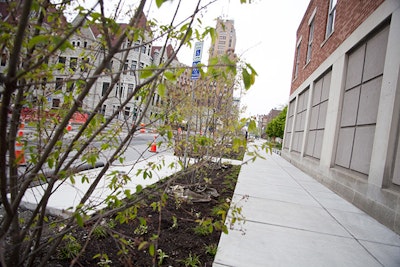Interested in Stormwater?
Get Stormwater articles, news and videos right in your inbox! Sign up now.
Stormwater + Get AlertsBy reforming its entire stormwater management program and changing the way residents think about water resources, Onondaga County, N.Y., evolved from the home of one of the most polluted lakes in the nation to one of the U.S. EPA's top 10 green communities.
Beginning with a lawsuit issued by the state in 1988, the county underwent a series of consent judgments to reduce the frequency of combined sewer overflow events that released sanitary flow and stormwater into Harbor Brook and Onondaga Creek, ultimately reducing the water quality of local water bodies, including Onondaga Lake. The lake became a Superfund site in 1994. In 1998, federal courts issued an amended consent judgment (ACJ) to Onondaga County to upgrade its wastewater treatment system within 15 years.
At the time, the county planned to satisfy the ACJ requirements by building more sewage treatment plants. A total of four treatment plants were scheduled along the Onondaga Creek in the City of Syracuse, where the majority of the combined sewer overflows were taking place. The Syracuse City Council fought the plan, filing lawsuits to prevent the county from demolishing homes in some lower-income neighborhoods. Ultimately the city council lost the battle and the Midland Avenue sewage treatment plant project was completed in early 2008.
Switching to
green solutions
In January 2008, just weeks before the finalization of plans for the second treatment plant, Joanie Mahoney took office as county executive for Onondaga County. Previously a city council member in Syracuse, Mahoney didn't believe sewage treatment plants were the best solution to reducing combined sewage overflows.
Mahoney asked contractors to hold their bids for 90 days so she could more thoroughly assess the situation. From previous experience with the Midland Avenue plant, she knew that green infrastructure provided very feasible options for improving stormwater management.
"I had an obligation to pursue a better way than just building another sewage treatment plant in downtown Syracuse," Mahoney says. "The information we had in 2008 was much different than the information my predecessor had in 1988 when the consent order was first put together. They didn't have all the choices we have today, but there was an unwillingness to see what new technologies existed and maybe adapt the plan along the way."
The county went back to the federal court and asked for a one-year extension on the next milestone for the ACJ. The request was granted. Mahoney's staff quickly assembled teams to explore green infrastructure, dusting off the research developed by a neighborhood group that had identified alternatives to the Midland Avenue plant. The National Resource Defense Council presented its Rooftops to Rivers initiative to the county, showing how other communities use green infrastructure as an alternative to treatment plants.
Mahoney sought locals who wanted to change the status quo in water treatment, such as the Onondaga Indian Nation. The group, which considers Onondaga Lake sacred ground, had previously been excluded from the decision-making process.
In addition, community groups joined the movement because they opposed the construction of new sewage treatment plants that would cause inconvenience during construction and be unsightly in the downtown area. Site preparations had already begun for the new treatment plant at Armory Square in Syracuse's thriving downtown business district, stirring concern from residents.
"The construction fence was up, the sign was up, the site was being cleared and there were big pipes on site," Mahoney says. "People saw that it was real that the county was going to build a treatment plant in downtown Syracuse. It wasn't theoretical; it was real. It got more of the community's attention."
Once there was solid evidence that environmental alternatives would be more effective for meeting the ACJ requirements and less costly in the long term, even parties who once opposed Mahoney's redirection efforts became allies, including city officials and the Atlantic States Legal Foundation, which filed the original lawsuit against the county for the sewage overflows.
Requesting an amendment
After a year of planning, the county had support from many groups, including the EPA. Onondaga County went back to the federal courts and asked that the ACJ be amended to include green infrastructure as a solution. As a sign of commitment to a green infrastructure plan, and to further persuade the court to agree to the amendment, the county suggested aggressively increasing the required capture rate — previously set as 87 percent capture by 2018 — to 95 percent.
"There was some hesitation from the court because there had been no precedent for them. There was no community we could point to and say they were successful," Mahoney says. "It was a leap of faith by the federal court to agree to the green infrastructure. They did it because all the parties came together to ask for the same thing."
On Nov. 16, 2009, the court signed a revised ACJ, and Onondaga County became the first municipality in the nation with a consent order that would require green infrastructure as a solution.
Save the Rain
At the heart of Onondaga County's new stormwater treatment system is a program called Save the Rain, which kicked off in fall 2010. The program incorporates a green infrastructure initiative called Project 50, supported by a Green Improvement Fund, a rain barrel program and an urban forestry program.
Project 50 was established as a goal to approve 50 distinct green infrastructure projects that return rainwater and melted snow into the ground for natural filtration instead of unnecessary treatment in the sewer system. Projects are funded through public dollars and include green roofs, porous pavement, rain gardens, bioswales and cisterns. In 2011, the county exceeded its goal by green-lighting 60 green infrastructure projects. Those projects combined are expected to capture 43.6 million gallons of stormwater annually. Total investment for the 2011 projects is $12.5 million.
One publicly lauded project is a green roof retrofitted on the convention center that captures more than a million gallons of water annually. A particularly innovative green infrastructure project involves a water reuse system on the local arena that collects and stores rainwater to make ice for a professional hockey team. Projects range in size from a porous sidewalk that captures 10,000 gallons annually to a green street project (using porous pavement and tree trenches) that captures more than 5.7 million gallons of water annually. There are green infrastructure projects in private and public areas including schools, libraries, community centers, parks, museums, parking lots, golf courses, zoos and apartment buildings.
Green Improvement Fund
The Green Improvement Fund (GIF) is a grant incentive program for private landowners, sponsored by the county's Department of Water Environment Protection. The fund provides a financial incentive to property owners in the Clinton, Harbor Brook and Midland combined sewersheds to install green infrastructure projects such as tree trenches, planter boxes, porous pavement, bioswales, rain gardens, green roofs, green streetscapes and cisterns.
Property owners who submit applications for the grant are chosen based on how many gallons of water their project will keep out of the sewage treatment system and the cost needed to complete the project. Projects that qualify for funding are those that provide the maximum benefit for the investment.
The GIF has proven to be one of the most innovative parts of Onondaga County's stormwater treatment programs.
"The public-private partnership [of the GIF] has attracted a lot of attention across the country because there is a real pressure on public dollars," Mahoney says. "We are partnering with private people to keep the water out of the municipal system. The grant makes the public dollars go further."
Rain barrel program
To get homeowners more involved, the county received a grant from the New York State Environmental Facilities Corporation to offer free rain barrels to citizens within the combined sewersheds of Syracuse. To receive a rain barrel, homeowners need to attend a workshop. So far, the county has distributed more than 600 free rain barrels for an estimated 2.1 million gallons of stormwater captured annually.
Urban Forestry Program
Tree plantings are an important part of the Save the Rain program because they absorb stormwater and reduce runoff. The Urban Forestry Program aims to plant up to 8,500 trees in Syracuse. The strategy has been to plant trees on properties where people want them first, to ensure the trees are maintained by committed homeowners.
Currently, the city has a higher demand for new tree plantings from interested citizens than it can fill. In 2011, the city planted 407 trees that will capture 814,000 gallons of stormwater annually. The city expects to plant another 1,000 trees throughout 2012, capturing another 2 million gallons of stormwater annually.
Program success
With the many green infrastructure projects supported by Save the Rain, Onondaga County expects to satisfy the ACJ 2018 capture rate ahead of schedule. Within the first couple years of the program, the county has already achieved 50 percent of its capture requirements.
Success, however, will be a double-edged sword for the county because once the ACJ order is satisfied, the lake will no longer be a Superfund site and public funding will be cut.
There are many other benefits to the Save the Rain project beyond meeting the ACJ mandate. The county is avoiding all the energy costs of unnecessarily pumping and treating stormwater like sewage. For Onondaga County, using green infrastructure is estimated to save $20 million over the lifetime of the projects compared to the lifetime costs of building and operating sewage treatment plants.
In addition, downtown Syracuse has seen a beautification from the green infrastructure projects. In 2011, Syracuse opened the Onondaga Creekwalk, a landscaped walking trail along the creek. Such a space wouldn't have been possible if the three additional treatment plants had been built along the creek.
By going back to a more natural way of handling stormwater, the community has changed the way it thinks about its future civic planning.
"There has been a mind shift from getting rid of water and treating it, to keeping it and using it," Mahoney says. "The Onondaga Indian Nation has a mantra that they make decisions in the best interest of people living seven generations from now. People have embraced that around here. We aren't making short-term decisions about how to solve a problem for today. We are making more long-term decisions about solving issues for generations to come."
In April 2012, the EPA awarded Onondaga County as one of the top green communities in the nation. Mahoney has taken that recognition seriously and wants to be a role model for other communities. By sharing details about the Save the Rain projects on its website, www.savetherain.us, Onondaga County hopes to help pave the way for other municipalities to adopt green infrastructure.
"We will all be better if people move to a more environmentally friendly strategy for managing stormwater runoff," Mahoney says. "It's better for people who live here and better for taxpayers. There's a knowledge about stormwater that didn't exist five years ago. People want to be more environmentally friendly. People stop me in the grocery store to talk about rain barrels and green roofs. It's been a great experience for the whole community."











